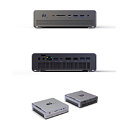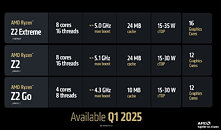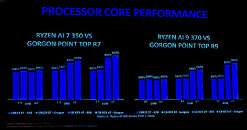Minisforum Showcases F1FGM MoDT Motherboard with Ryzen 9 9955HX at Japan IT Week
Minisforum is working on a new MoDT (Mobile on Desktop) motherboard lineup featuring mobile versions of AMD Ryzen processors, one of them being the F1FGM model. The motherboard came in a compact microATX form factor built around the AMD X870M chipset and is equipped with the latest AMD Ryzen 9 9955HX processor rather than traditional socket-type processors. This CPU has a boost clock of up to 5.4 GHz and is based on the Zen 5 architecture offering 16 cores, 32 threads, and 64 MB of L3 cache. Interestingly, even if this processor is rated at 55 W by default, in this particular Minisforum implementation it can be pushed up to a whopping 160 W. To efficiently dissipate the substantial 160 W thermal output and considering that mobile CPUs don't have an IHS, the motherboard comes equipped with a pre-installed vapor chamber heat spreader. The VRM features a solid design with 13-phase 60 A SPS DrMOS. Minisforum has also included large heatsinks across the VRMs, M.2 Slots and PCH.
For expansion, the Minisforum F1FGM motherboard offers one PCIe 5.0 x16 slot and one PCIe 4.0 x16 slot. Storage interfaces include one PCIe 5.0 compatible M.2 slot, three additional M.2 slots (one is rated at Gen 5 x4), two SATA 6 Gbps connections and two BIOS Debug LEDs. On the connectivity side it features two USB4 ports, one HDMI, one DisplayPort, five Gigabit Ethernet, and Wi-Fi 7 compatibility. The four 5 V ARGB LED control pin headers is a clear step towards DIY users and according to company representatives, the main competition for this motherboard will be ASUS ROG products. PCWatch reports that Minisforum intends to offer the F1FGM motherboard at a price point comparable to a standalone desktop CPU in the second half of this year.
For expansion, the Minisforum F1FGM motherboard offers one PCIe 5.0 x16 slot and one PCIe 4.0 x16 slot. Storage interfaces include one PCIe 5.0 compatible M.2 slot, three additional M.2 slots (one is rated at Gen 5 x4), two SATA 6 Gbps connections and two BIOS Debug LEDs. On the connectivity side it features two USB4 ports, one HDMI, one DisplayPort, five Gigabit Ethernet, and Wi-Fi 7 compatibility. The four 5 V ARGB LED control pin headers is a clear step towards DIY users and according to company representatives, the main competition for this motherboard will be ASUS ROG products. PCWatch reports that Minisforum intends to offer the F1FGM motherboard at a price point comparable to a standalone desktop CPU in the second half of this year.










































































